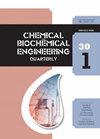煤在移动床反应器中气化生产适合甲醇生产装置的合成气的模拟与优化
IF 0.9
4区 生物学
Q4 BIOTECHNOLOGY & APPLIED MICROBIOLOGY
引用次数: 0
摘要
本文以匹兹堡8号煤为原料,对移动床反应器内的煤气化过程进行了模拟和优化。采用四阶龙格-库塔法求解质量平衡和能量平衡的微分方程组,并采用非支配排序遗传算法- ii (NSGA-II)方法进行优化。利用模拟方法预测了反应器沿线的固体和气体温度分布以及气体成分。模拟结果与苏格兰韦斯特菲尔德电厂的实验数据进行了比较。此外,还考察了煤氧摩尔比、蒸汽氧摩尔比、进气温度、反应器压力、进气氧摩尔分数等操作参数对合成气产量、合成气中氢与一氧化碳摩尔比和煤转化率的影响。最后,采用NSGA-II法对反应器性能进行了优化,使其在HCMR为2的情况下产生最高的合成气。本文章由计算机程序翻译,如有差异,请以英文原文为准。
Simulation and Optimization of Coal Gasification in a Moving-bed Reactor to Produce Synthesis Gas Suitable for Methanol Production Unit
This paper presents process simulation and optimization of coal gasification process in a moving-bed reactor using Pittsburgh No. 8 coal as feed. The system of differential equations for the mass and energy balances was solved using 4th-order Runge-Kutta method and optimized by non-dominated sorting genetic algorithm-II (NSGA-II) method. The simulation was used to predict solid and gas temperature profile and gas composition along the reactor. The simulation results were compared successfully with experimental data relevant to Westfield plant in Scotland. In addition, the effect of operating parameters such as coal-to-oxygen molar ratio, steam-to-oxygen molar ratio, inlet gas temperature, reactor pressure, and oxygen mole fraction in inlet air on amount of synthesis gas (syngas) production, hydrogen to carbon monoxide molar ratio (HCMR) in produced syngas, and coal conversion was investigated. Finally, the reactor performance was optimized to produce the highest syngas production with a HCMR of two using NSGA-II method.
求助全文
通过发布文献求助,成功后即可免费获取论文全文。
去求助
来源期刊
CiteScore
2.70
自引率
6.70%
发文量
23
审稿时长
>12 weeks
期刊介绍:
The journal provides an international forum for presentation of original papers, reviews and discussions on the latest developments in chemical and biochemical engineering. The scope of the journal is wide and no limitation except relevance to chemical and biochemical engineering is required.
The criteria for the acceptance of papers are originality, quality of work and clarity of style. All papers are subject to reviewing by at least two international experts (blind peer review).
The language of the journal is English. Final versions of the manuscripts are subject to metric (SI units and IUPAC recommendations) and English language reviewing.
Editor and Editorial board make the final decision about acceptance of a manuscript.
Page charges are excluded.

 求助内容:
求助内容: 应助结果提醒方式:
应助结果提醒方式:


